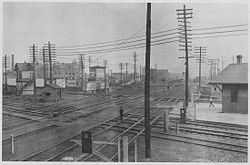History
Nineteenth century
The area was developed by Paul Cornell, the developer of what is now Hyde Park, Chicago, throughout the 1870s. Grade separation did not occur at the rail crossing until 1912. [2] Greater Grand Crossing was historically a railroad suburb made up of five, independently developed, older ethnic neighborhoods. The Grand Crossing and Brookline neighborhoods were predominantly made up of German immigrant craftsmen, farmers and factory workers; Essex had residents of English, Irish and Scottish immigrants who worked for the railroads; Brookdale was settled mostly by Chicago-born residents employed in the building trades and by the railroads; and Park Manor, the last of these smaller neighborhoods to develop, had residents who were predominantly of east-coast Yankee stock. [3]
Twentieth century
At the start of the twentieth century, portions of Greater Grand Crossing like other neighborhoods in Chicago made the transition from open space and farmland to bungalow neighborhood. [4]
Demographics
By the 1930s, the railroad workers residing in the neighborhood were joined by Swedes and Italians. Throughout the next two decades, African Americans began moving into the neighborhood from the overcrowded Black Belt and that's when Grand Crossing's White residents began to move out of the neighborhood. During the 1950s, the Black population of the neighborhood rose from 6% to 86%.
According to data from the 2014–2018 American Community Survey compiled by the Chicago Metropolitan Agency for Planning, there were 30,805 people and 12,230 households in Greater Grand Crossing. The racial makeup of the area was 1.1% White, 96.2% African American, and 1.5% from other races. Hispanic or Latino of any race were 1.2% of the population. [5]
In the area, the population was spread out, with 32.4% under the age of 19, 17.6% from 20 to 34, 18.6% from 35 to 49, 19.5% from 50 to 64, and 12.0% who were 65 years of age or older. The median age was 35.2 years compared to 34.3 years. [5]
Historical population| Census | Pop. | Note | %± |
|---|
| 1930 | 60,007 | | — |
|---|
| 1940 | 61,554 | | 2.6% |
|---|
| 1950 | 61,753 | | 0.3% |
|---|
| 1960 | 63,169 | | 2.3% |
|---|
| 1970 | 54,414 | | −13.9% |
|---|
| 1980 | 45,218 | | −16.9% |
|---|
| 1990 | 38,644 | | −14.5% |
|---|
| 2000 | 38,619 | | −0.1% |
|---|
| 2010 | 37,465 | | −3.0% |
|---|
| 2020 | 31,471 | | −16.0% |
|---|
|
Features
The Oak Woods Cemetery, established in 1854, is located in Greater Grand Crossing.
Since 2006, Artist Theaster Gates has redeveloped several buildings in Grand Crossing as art and community centers. [21]
The community has since been redeveloped in slow progression and will be a historic landmark for future generations.
This page is based on this
Wikipedia article Text is available under the
CC BY-SA 4.0 license; additional terms may apply.
Images, videos and audio are available under their respective licenses.



